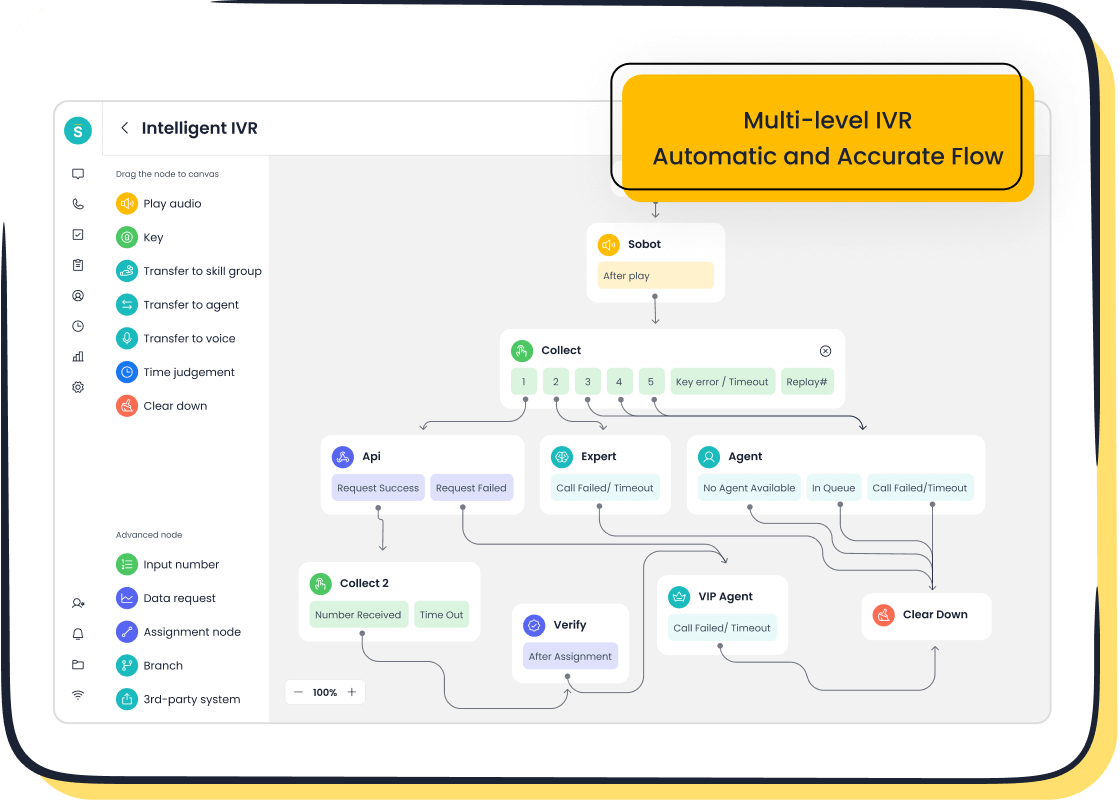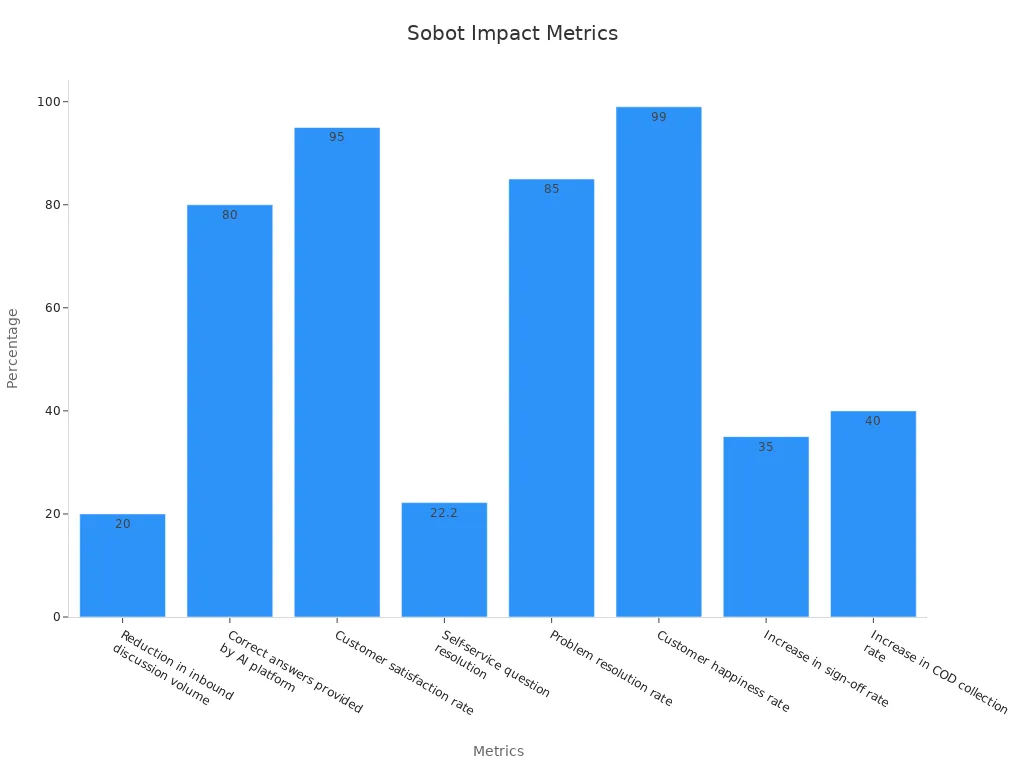Building the Perfect Customer Service Evaluation Form

Customer service evaluation tools play a vital role in enhancing satisfaction and operational efficiency. They provide businesses with a structured way to gather insights into customer experiences. For example, companies using effective customer service strategies often see a 15% increase in satisfaction, which fosters loyalty. These tools also help identify strengths and areas for improvement, leading to better communication and understanding of customer needs.
Analyzing performance data allows you to pinpoint areas needing improvement and take corrective actions. This process not only boosts satisfaction but also strengthens customer relationships.

Sobot offers innovative solutions like its Voice/Call Center, which integrates seamlessly with customer service evaluation tools. By leveraging such technologies, businesses can streamline feedback collection and improve service quality.
Understanding the Purpose of Customer Service Evaluation
Why Customer Service Evaluation Forms Matter
Measuring customer satisfaction and service quality
Customer service evaluation forms are essential tools for assessing how well your business meets customer expectations. They help you measure satisfaction levels and service quality by collecting direct feedback. For instance, 58% of customers stop engaging with a brand after a single negative experience. This statistic underscores the importance of evaluating your service to prevent such losses. Additionally, businesses that focus on personalized experiences see a 70% increase in customer satisfaction, proving that tailored interactions can significantly enhance loyalty.

Using evaluation forms, you can track key metrics like response time, professionalism, and problem resolution. These insights allow you to identify what works and what needs improvement. Sobot’s Voice/Call Center, for example, offers real-time monitoring and analysis of customer interactions, making it easier to gather and act on feedback. By leveraging such tools, you can ensure your service consistently meets high standards.
Identifying areas for improvement in customer interactions
Evaluation forms also help you pinpoint weaknesses in your customer interactions. Quality assurance programs often use data from these forms to assess performance. Metrics like post-call survey results and compliance checks directly correlate with customer satisfaction scores. High scores indicate that your team is meeting expectations, while lower scores highlight areas needing attention.

For example, incorporating customer experience metrics into your evaluation process can provide deeper insights. These metrics, such as first-call resolution rates, emphasize the importance of resolving issues quickly and effectively. Sobot’s intelligent IVR system supports this goal by routing calls efficiently, reducing wait times, and improving overall satisfaction. By identifying and addressing gaps, you can create a more seamless and positive experience for your customers.
Defining Goals for Your Customer Evaluation Form
Aligning the form with business objectives
Your customer evaluation form should align with your business goals. Whether you aim to improve customer satisfaction, increase loyalty, or enhance operational efficiency, the form must reflect these objectives. For example, businesses with high customer satisfaction often experience higher revenue growth. Setting measurable goals like improving Net Promoter Scores (NPS) or first-call resolution rates can guide your evaluation efforts.
| Measurable Objective | Description |
|---|---|
| Customer Satisfaction Goals | Objectives aimed at improving overall customer experience and fostering loyalty. |
| Net Promoter Score (NPS) | Measures customer loyalty and likelihood of recommending the business. |
| First-Call Resolution (FCR) Rate | Tracks the percentage of issues resolved on the first contact, enhancing customer trust. |
| Customer Satisfaction (CSAT) Scores | Evaluates customer satisfaction with specific interactions or services. |
Sobot’s solutions, like its AI-powered Voicebot, can help you achieve these goals by providing actionable insights and streamlining customer interactions.
Ensuring the form collects actionable insights
An effective customer evaluation form should gather data that you can act on. Avoid vague questions and focus on specific aspects of your service, such as response time or agent professionalism. For instance, asking, “How satisfied were you with the resolution of your issue?” provides clear feedback that you can use to improve.
Including follow-up questions can also help you understand the reasons behind a customer’s rating. Sobot’s unified workspace simplifies this process by integrating customer data and feedback into one platform. This feature allows you to analyze responses quickly and implement changes that enhance satisfaction. By designing your form thoughtfully, you can turn feedback into meaningful improvements.
Steps to Build the Perfect Customer Service Evaluation Form

Step 1: Conduct Research
Understand your audience and their feedback needs
To create customer evaluation forms that deliver actionable insights, you must first understand your audience. Feedback forms are an excellent way to gather real-time data about customer experiences. They highlight key areas for improvement and help you gauge common issues customers face. For example, these forms can predict why some customers choose not to convert, allowing you to address those concerns proactively. Listening to customer opinions also builds trust and strengthens relationships.
By analyzing responses, you can measure customer experience against their expectations. This process not only improves service quality but also provides insights into product usability and content effectiveness. Sharing this information with stakeholders ensures everyone is aligned on areas needing attention.
Analyze existing feedback channels for insights
Before designing your form, review your current feedback channels. Post-call surveys, for instance, offer valuable insights into whether customer inquiries were resolved effectively. These surveys also help you assess satisfaction levels, providing a holistic view of your service quality. Evaluation research is particularly useful when launching new products or services, as it allows you to gather feedback from your target audience to identify what works and what doesn’t.

Sobot’s Voice/Call Center simplifies this process by integrating customer feedback into a unified workspace. This feature enables you to analyze data quickly and make informed decisions to enhance your service.
Step 2: Design Clear and Relevant Questions
Use a mix of open-ended and closed-ended questions
Combining open-ended and closed-ended questions ensures you collect both quantitative and qualitative data. Closed-ended questions, such as “Rate our service on a scale of 1 to 5,” provide measurable insights that are easy to analyze. However, they may limit customer expression. Open-ended questions, like “What could we do to improve your experience?”, allow customers to share detailed feedback, offering deeper insights into their needs.
| Question Type | Strengths | Weaknesses |
|---|---|---|
| Closed-ended | Collects quantitative data that is easy to analyze | Limits customer expression to predefined options |
| Open-ended | Provides rich, authentic responses | Difficult and time-consuming to analyze |
Using both types of questions ensures your form captures a comprehensive view of customer experiences.
Focus on specific aspects of customer service (e.g., response time, professionalism)
Your questions should target specific areas of customer service. For example, ask about response time, agent professionalism, or issue resolution. Specific questions, such as “How satisfied were you with the agent’s professionalism?”, provide actionable insights. Avoid vague questions that don’t lead to clear improvements.
Sobot’s AI-powered Voicebot can enhance this process by collecting detailed feedback during interactions. This tool helps you identify areas where your team excels and where improvements are needed.
Step 3: Choose the Right Rating Scales
Use consistent scales (e.g., 1-5 or 1-10) for clarity
Consistency in rating scales is crucial for reliable evaluations. Scales like 1-5 or 1-10 are widely used across industries because they simplify data analysis. For example, a 1-5 scale can measure satisfaction levels, while a 1-10 scale might assess the likelihood of recommending your service. Defined metrics, such as Customer Satisfaction (CSAT) and First Call Resolution (FCR), ensure consistency and provide actionable insights.
Include a 'Not Applicable' option for irrelevant questions
Adding a ‘Not Applicable’ option prevents customers from providing inaccurate responses to questions that don’t apply to them. This option improves the reliability of your data and ensures you focus on relevant feedback. For instance, if a customer didn’t interact with an agent, they can select ‘Not Applicable’ for questions about agent professionalism.
Sobot’s Voice/Call Center supports this approach by offering customizable feedback forms. These forms allow you to tailor questions to your audience, ensuring you collect meaningful data.
Step 4: Create a User-Friendly Layout
Keep the form concise and visually appealing
A concise and visually appealing form encourages customers to complete it. Avoid overwhelming users with too many questions. Instead, focus on the most critical aspects of your service. For example, forms with fewer than 10 questions often achieve higher completion rates. Use clean fonts, adequate spacing, and a simple design to make the form easy to read.
| Metric Description | Impact on Form Completion Rates |
|---|---|
| Users couldn't find the account settings button | 72% of users used search instead, indicating navigation issues. |
| Time spent looking for the signup button | 15.7 seconds on average, with 67% abandoning the task. |
| Indirect success rate for pricing information | 90% success rate despite alternative paths. |
Sobot’s Voice/Call Center allows you to customize feedback forms with a user-friendly interface, ensuring customers can navigate them effortlessly.
Use logical sections to group related questions
Organizing questions into logical sections improves clarity. Group related questions under headings like "Agent Professionalism" or "Resolution Time." This structure helps customers focus on one topic at a time, reducing confusion. Logical grouping also simplifies data analysis, as you can easily identify trends in specific areas of your service.
Step 5: Test the Form
Gather feedback from a small group of users
Before launching your form, test it with a small group of users. This step helps identify usability issues. For instance, in a pilot test, unclear instructions caused confusion among participants. Adjustments to the design resolved these issues, improving the form's effectiveness. Testing ensures your form collects accurate and actionable feedback.
- Google's Android beta program uses pilot testing to identify usability issues before full deployment. This approach highlights the importance of pre-launch testing.
Make adjustments based on usability and clarity
Use insights from testing to refine your form. If users find certain questions unclear or irrelevant, revise them. For example, reducing the complexity of instructions can significantly improve user comprehension. Sobot’s unified workspace simplifies this process by integrating feedback into one platform, enabling you to make data-driven adjustments.
Step 6: Share and Collect Responses
Use multiple channels (e.g., email, website, social media)
Distribute your form across multiple channels to maximize reach. Email, websites, and social media platforms are effective options. Using diverse channels ensures you capture feedback from a broad audience. For example, businesses that collect responses through multiple touchpoints often gain a more comprehensive understanding of the customer journey.
| Metric | Description |
|---|---|
| Customer Satisfaction | Measures how products and services meet customer expectations, indicating overall satisfaction. |
| Net Promoter Score | Assesses customer loyalty and likelihood to recommend, providing insight into customer sentiment. |
| Comprehensive Feedback | Captures insights from various touchpoints, allowing for a holistic view of the customer journey. |
Ensure the form is mobile-friendly for wider accessibility
A mobile-friendly form ensures accessibility for all users. Over 50% of web traffic comes from mobile devices, making mobile optimization essential. Test your form on various devices to ensure it functions seamlessly. Sobot’s Voice/Call Center supports mobile-friendly feedback forms, enabling you to reach customers wherever they are.
Best Practices for Effective Customer Service Evaluation Forms
Keep It Short and Simple
Limit the number of questions to avoid survey fatigue
Shorter forms lead to higher completion rates and better feedback quality. When you limit the number of questions, customers feel less overwhelmed and are more likely to provide thoughtful responses. For example, breaking questions into smaller groups or pages increases completion rates significantly. Adaptive questioning techniques have even doubled response rates in some cases. Focus on key aspects of your service, such as resolution time or agent professionalism, to gather meaningful insights without exhausting your audience.
Use clear and straightforward language
Simple language ensures customers understand your questions easily. Avoid jargon or overly technical terms that might confuse respondents. For instance, instead of asking, “Evaluate the efficacy of our resolution process,” you could ask, “How satisfied were you with how your issue was resolved?” Clear questions improve response accuracy and make feedback actionable. Sobot’s Voice/Call Center supports customizable forms, allowing you to craft concise and easy-to-understand questions tailored to your audience.
Make It Mobile-Friendly
Optimize the form for mobile devices
Over half of web traffic comes from mobile users, making mobile optimization essential for your evaluation forms. Design forms that are easy to navigate on smaller screens. Use large buttons, readable fonts, and minimal scrolling to enhance usability. Sobot’s Voice/Call Center ensures feedback forms are mobile-friendly, enabling customers to share their experiences conveniently from any device.
Test responsiveness across different platforms
Testing your form on various devices ensures it works seamlessly for all users. Check for issues like misaligned text or buttons that are hard to click. A well-tested form improves accessibility and increases response rates. Businesses that prioritize mobile responsiveness often see higher engagement and richer feedback. By ensuring compatibility across platforms, you make it easier for customers to provide valuable insights.
Focus on Actionable Insights
Avoid vague or overly broad questions
Specific questions yield actionable data. Instead of asking, “How was your experience?” you could ask, “How satisfied were you with the agent’s response time?” This approach helps you identify clear priorities for improvement. Metrics like First Contact Resolution (FCR) and Net Promoter Score (NPS) provide measurable insights that guide operational decisions.
Include follow-up questions for deeper insights
Follow-up questions uncover the reasons behind customer ratings. For example, if a customer rates their satisfaction as low, asking, “What could we have done better?” provides context for their feedback. This strategy helps you address pain points effectively. Sobot’s unified workspace integrates feedback analysis, enabling you to act on insights quickly and improve service quality.
Ensure Anonymity and Confidentiality
Reassure respondents their feedback is private
When customers provide feedback, they want to feel secure. Reassuring them that their responses are private builds trust and encourages participation. You can include a brief statement at the beginning of your evaluation form, such as, “Your feedback will remain confidential and used solely for improving our services.” This simple step can significantly increase response rates.
Studies show that 74% of people are more likely to complete surveys when they know their data is protected. Transparency about how you handle feedback fosters confidence. For example, you can explain that responses are anonymized before analysis. Sobot’s Voice/Call Center supports this by securely collecting and storing customer feedback. Its encrypted data transfer ensures that sensitive information stays protected, meeting global privacy standards.
Tip: Use clear language to explain your privacy policy. Avoid technical jargon that might confuse respondents.
Use anonymous surveys to encourage honest responses
Anonymous surveys often yield more honest and detailed feedback. When customers know their identities are hidden, they feel free to share their true opinions. This is especially important for identifying areas where your service may fall short. For instance, a study by Harvard Business Review found that anonymous feedback is 30% more likely to highlight critical issues.
You can design your forms to exclude personal identifiers like names or contact details. Sobot’s customizable feedback forms make this process simple. By enabling anonymous submissions, you can gather unfiltered insights that drive meaningful improvements. Additionally, anonymous surveys are ideal for post-call evaluations, where customers might hesitate to critique agents directly.
Note: Always test your anonymous survey to ensure it functions as intended. This step helps you avoid technical glitches that could compromise anonymity.
Recommended Tools and Templates for Customer Service Evaluation

Tools for Creating Online Evaluation Forms
Google Forms
Google Forms is a free and user-friendly tool for creating an online evaluation form. It allows you to design forms with various question types, such as multiple-choice, linear scales, and short answers. You can also customize the form’s appearance to match your brand. Google Forms automatically organizes responses into spreadsheets, making it easy to analyze feedback. This tool is ideal for small businesses or teams looking for a straightforward customer service evaluation tool.
Typeform
Typeform stands out for its interactive and visually appealing design. It enables you to create conversational forms that engage users. With features like conditional logic, you can tailor questions based on previous answers, ensuring a personalized experience. Typeform also integrates with tools like Google Sheets and Slack, helping you manage feedback efficiently. This makes it a great choice for businesses aiming to enhance user engagement through their evaluation forms.
SurveyMonkey
SurveyMonkey is a robust platform for creating detailed online evaluation forms. It offers advanced features like survey templates, data analysis tools, and customizable branding options. You can use its built-in analytics to track trends and measure customer satisfaction over time. SurveyMonkey’s scalability makes it suitable for businesses of all sizes, from startups to large enterprises.

Sobot's Voice/Call Center for integrated customer feedback
Sobot’s Voice/Call Center provides a comprehensive solution for collecting and analyzing customer feedback. Its intelligent IVR system allows you to gather responses directly during calls, streamlining the feedback process. The unified workspace integrates all customer interactions, enabling you to analyze data in real time. With features like customizable evaluation form templates and mobile-friendly designs, Sobot ensures you can create forms that align with your business needs. This tool is perfect for businesses seeking a customer service evaluation tool that combines efficiency with actionable insights.
Templates to Simplify the Process
Pre-designed customer service evaluation templates
Pre-designed templates simplify the process of creating evaluation forms. They streamline feedback collection by offering ready-to-use formats with clear and concise questions. These templates ensure consistency in data collection, improving the accuracy of your insights. For example, a template might include questions about response time, professionalism, and issue resolution, helping you focus on key service aspects.
- Benefits of pre-designed templates:
- Streamline the feedback collection process.
- Ensure consistency in data collection.
- Improve response accuracy with clear questions.
Customizable forms for specific industries
Customizable templates allow you to tailor evaluation forms to your industry’s unique needs. For instance, a retail business might focus on questions about product availability, while a financial service provider could prioritize security and trust. Customizable forms enhance user engagement by addressing specific concerns. They also support diverse question types, such as rating scales and open-ended questions, providing a comprehensive understanding of customer feedback.
Sobot’s Voice/Call Center offers customizable templates that cater to various industries. These templates help you create forms that resonate with your audience, ensuring you collect meaningful and actionable feedback.
Leveraging Sobot for Customer Service Evaluation
How Sobot's Voice/Call Center Enhances Feedback Collection
Intelligent IVR for automated feedback routing
Sobot’s Intelligent IVR system simplifies the process of collecting customer feedback. It uses automated menus to route calls to the right agents or teams. This feature ensures that customers reach the appropriate department quickly, reducing wait times and improving satisfaction. For example, businesses using Sobot’s IVR have seen a 20% reduction in inbound discussion volume. The system also provides over 80% accuracy in delivering correct answers, which enhances the overall customer experience.
By automating feedback routing, Sobot’s IVR eliminates the need for manual intervention. This efficiency allows your team to focus on resolving issues rather than managing call transfers. Additionally, the IVR system integrates seamlessly with other tools, making it easier to collect and analyze feedback in real time.
Unified workspace for managing customer interactions
Sobot’s unified workspace brings all customer interactions into one platform. This feature allows agents to access call data, feedback, and customer history in a single view. With this streamlined approach, your team can respond to inquiries faster and more effectively.
For instance, the unified workspace supports real-time monitoring, enabling agents to track customer satisfaction during calls. This capability has contributed to a 96% increase in positive feedback for businesses using Sobot’s solutions. By centralizing data, the workspace also simplifies the process of identifying trends and areas for improvement.
Benefits of Using Sobot for Customer Evaluation
Real-time monitoring and analysis of feedback
Sobot’s Voice/Call Center offers real-time monitoring tools that help you track customer feedback as it happens. This feature allows you to identify issues immediately and take corrective action. For example, businesses using Sobot have achieved a 95% customer satisfaction rate and an 85% problem resolution rate.
The platform’s analytics tools provide detailed insights into customer interactions. These insights help you measure key metrics like response time and resolution rates. By acting on this data, you can improve your service quality and enhance customer loyalty.
Seamless integration with existing systems
Sobot’s solutions integrate effortlessly with your existing systems, such as CRM platforms. This compatibility ensures that you can collect and analyze feedback without disrupting your current workflows. For example, Sobot’s Voice/Call Center supports encrypted data transfer, ensuring secure and reliable operations.
The platform also offers customizable templates for evaluation forms, making it easy to tailor feedback collection to your business needs. This flexibility has led to a 40% increase in COD collection rates and a 35% rise in sign-off rates for businesses using Sobot.
| Metric Description | Value |
|---|---|
| Reduction in inbound discussion volume | 20% |
| Increase in positive feedback | 96%+ |
| Correct answers provided by AI platform | 80% |
| Customer satisfaction rate | 95% |
| Self-service question resolution | 22.2% |
| Problem resolution rate | 85% |
| Customer happiness rate | 99% |
| Increase in sign-off rate | 35% |
| Increase in COD collection rate | 40% |

By leveraging Sobot’s advanced features, you can transform your customer service evaluation process into a powerful tool for growth and improvement.
A well-designed customer service evaluation form helps you improve satisfaction and gather actionable insights. It allows you to identify strengths and address weaknesses in your service. For example, businesses using structured feedback forms often see a 20% increase in customer retention.
Sobot’s Voice/Call Center simplifies this process with tools like intelligent IVR and real-time analytics. These features make feedback collection seamless and effective. Start building your form today using the steps and best practices shared here. Continuous improvement ensures your service stays ahead of customer expectations.
Tip: Visit Sobot’s website to explore solutions that enhance your customer service evaluation process.
FAQ
What makes a customer service evaluation form effective?
An effective form collects actionable insights through clear, concise, and relevant questions. It uses a mix of open-ended and closed-ended questions to gather both quantitative and qualitative data. Tools like Sobot’s Voice/Call Center simplify this process by offering customizable templates and real-time analytics for better feedback collection.
How can you encourage customers to complete evaluation forms?
You can increase completion rates by keeping forms short and visually appealing. Offering incentives, such as discounts or loyalty points, also motivates customers. Sobot’s mobile-friendly forms ensure accessibility, making it easier for customers to provide feedback on any device.
Why is mobile optimization important for evaluation forms?
Over 50% of web traffic comes from mobile devices. Mobile-friendly forms improve accessibility and completion rates. Sobot’s Voice/Call Center ensures your forms are optimized for mobile use, allowing customers to share feedback conveniently, whether they’re on a smartphone or tablet.
How does Sobot’s Voice/Call Center improve feedback collection?
Sobot’s Voice/Call Center uses intelligent IVR to automate feedback routing and a unified workspace to centralize customer interactions. These features streamline the feedback process, enabling you to collect and analyze data in real time. Businesses using Sobot report higher customer satisfaction and improved service quality.
What are the benefits of using anonymous surveys?
Anonymous surveys encourage honest feedback by protecting customer identities. This approach helps you identify critical issues without bias. Sobot’s customizable forms support anonymous submissions, ensuring privacy and fostering trust. Studies show anonymous surveys increase response rates by up to 30%.
See Also
Enhancing Customer Satisfaction Through Effective Live Chat Strategies
The Ultimate List of Customer Service Software for 2024
Essential Practices for Effective Call Center Quality Management
Navigating the Best Quality Assurance Software for Call Centers
Key Considerations for Selecting Social Media Customer Service Tools
